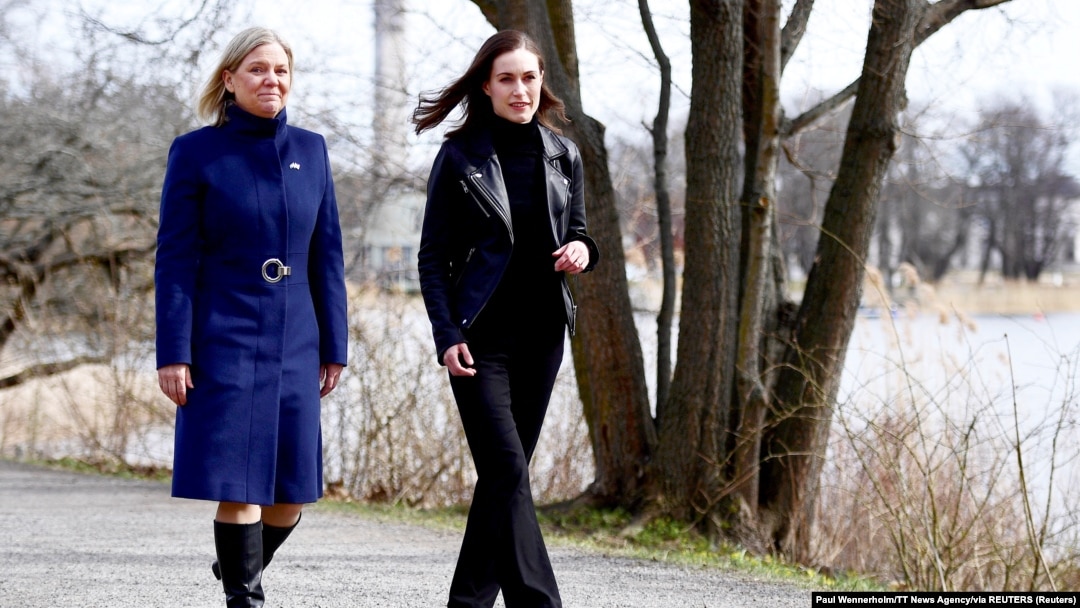It is almost a certainty now that Finland and Sweden will join NATO, making it the biggest political and military redrawing of the European map since the countries of Central and Eastern Europe joined the military alliance, as well as the European Union, in different waves in the late 1990s and early 2000s.
The big questions right now are no longer if, but rather when Finland and Sweden will join NATO, if they will do so together, and -- perhaps most crucially -- if they will get certain security guarantees in the (likely) period of months between their applications and actually being approved as full members of the alliance.

Make no mistake that this is a big Copernican shift in two countries that have been militarily nonaligned since the end of World War II.
For Finland, it will be the ultimate move in finally unshackling itself from the Cold War notion of “Finlandization,” when the Soviet Union let the country be independent but had a big influence on its policy choices.
For Sweden, the sense of being “neutral” has been shaping its political life for decades, if not centuries. Having managed to stay out of both world wars during the 20th century, its last recognized military conflict was against Norway in 1814.
It is, in other words, a big deal for both countries.
It is, therefore, even more startling how fast the decision process is going in both Helsinki and Stockholm this spring. There is a “before and after February 24,” said Swedish Prime Minister Magdalena Andersson as she received her Finnish counterpart, Sanna Marin, in the Swedish capital earlier this week, referring to Russia’s invasion of Ukraine.
The Kremlin’s war has concentrated minds, and subsequent threats by Moscow as the pair edge closer to NATO have just stiffened their resolve. So much so that the Nordic duo is now considering joining even without referendums in either country.
Burgeoning Support
Marin confirmed in Stockholm that the Finnish parliament and its various committees will now debate whether to join the military alliance or not, but that a decision is expected “in weeks and not months.”
Nonetheless, it is already clear what the decision will be. Nearly 70 percent of the Finnish population supports membership, according to a recent poll, and hesitant parties such as the populist Finns Party and the Center Party are now indicating that they are in favor of joining. Expect an application to land on NATO Secretary-General Jens Stoltenberg’s desk as early as May.
Swedish armored regiments take part in joint exercises with NATO troops in 2017.
Finland is leading the charge currently, but Sweden seems to be riding on the coattails of its eastern neighbor. The governing Social Democrats, a champion of nonalignment, is currently having internal debates about it, but media reports say that Prime Minister Andersson favors membership. The four center-right parties in the parliament are already on board, and the populist right-wing Sweden Democrats have indicated that they are up for it if Finland joins.
Therefore, a parliamentary majority exists, and -- while the latest opinion polls show that 45 percent of Swedes would join compared to 33 percent against and 22 percent undecided -- surveys indicate that the number of those supporting membership would jump to well over 60 percent if Finland joined as well. Don’t be surprised to see a Swedish application follow shortly after the Finnish one, as Stockholm appears to want this question sorted before Swedish parliamentary elections due in late September.
That begs the question as to whether the two would join together. While officials from both countries insist that they will make separate decisions, they are also confirming that relevant Swedish and Finnish ministers are in contact on the issue on a weekly, if not daily, basis. It is, however, clear that both entering at the same time would strengthen their respective bids -- and make it even easier for NATO to open its doors.
Security Guarantees?
It is also clear that NATO would welcome the pair with open arms. There are no indications that any other current member has any issues with the pair, and Stoltenberg has described them as being as close to NATO as they can possibly be without being members. Both armies regularly participate in alliance exercises and are already fully interoperable with those of the other 30 members.
On top of this, Finland, which still has general conscription, can muster a wartime army of 280,000 personnel, plus additional reservists, and Sweden has a substantial high-tech military industry. Both are also ready to reach NATO’s target of devoting 2 percent of gross domestic product to defense spending in the coming years.
So, when can they join?
The most optimistic scenario in Brussels is that both can sign their accession protocols at the NATO summit in Madrid on June 29-30. That speed would be unprecedented, but many officials add that we “live in unprecedented times” when old procedures are constantly being rewritten.
Finnish Foreign Minister Pekka Haavisto has noted that the ratification process after the protocols have been signed can take from three months to a year as some of the 30 alliance members’ national parliaments discuss the issue in various committees.
There’s also the chance that the accession bill could become collateral damage caused by domestic political bargaining. For example, it took 13 months for North Macedonia, the latest NATO member, to go from signing the accession protocols to full membership.
Both Sweden and Finland, however, have pressed other alliance members to speed up the process, because the “gray zone” they might enter soon is a worry, especially along the nearly 1,400-kilometer-long stretch between Finland and Russia that might soon become NATO’s longest border with its eastern adversary.
Haavisto has conceded that NATO’s mutual defense clause, Article 5, only covers full members. But don’t rule out the idea that some sort of security guarantees might be sought for this period, bilaterally or otherwise, with Article 42.7 of the EU treaty also stipulating that other member states have “an obligation of aid and assistance by all the means in their power” in the event that another member state comes under attack.
The safest bet, however, is that parliaments across the continent might take an urgent break from their summer recesses in July and August this year to make Finland and Sweden NATO’s 31st and 32nd members by early autumn.


